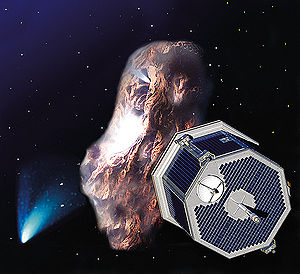CONTOUR

Artists' impression of CONTOUR approaching a comet.
|
|
| Mission type | Flyby (2P/Encke · 73P/Schwassmann–Wachmann · 6P/d'Arrest) |
|---|---|
| Operator | NASA · Applied Physics Laboratory |
| COSPAR ID | 2002-034A |
| Mission duration | 1 month, 12 days |
| Spacecraft properties | |
| Launch mass | 328 kg (723 lb) |
| Start of mission | |
| Launch date | July 3, 2002 06:47:41 UTC (14 years, 8 months and 18 days ago) |
| Rocket | Delta II |
| Launch site | Cape Canaveral SLC-17 |
| Contractor | Boeing |
| End of mission | |
| Last contact | August 15, 2002 (14 years, 7 months and 6 days ago) |
|
|
|
The COmet Nucleus TOUR (CONTOUR) was a NASA Discovery-class space probe that failed shortly after its July 2002 launch. It had as its primary objective close flybys of two comet nuclei with the possibility of a flyby of a third known comet or an as-yet-undiscovered comet.
The two comets scheduled to be visited were Encke and Schwassmann-Wachmann-3, and the third target was d'Arrest. It was hoped that a new comet would have been discovered in the inner Solar System between 2006 and 2008, in which case the spacecraft trajectory would have been changed if possible to rendezvous with the new comet. Scientific objectives included imaging the nuclei at resolutions of up to 4 meters (13 ft), performing spectral mapping of the nuclei at resolutions of up to 100 meters (330 ft), and obtaining detailed compositional data on gas and dust in the near-nucleus environment, with the goal of improving knowledge of the characteristics of comet nuclei.
After the solid rocket motor intended to inject the spacecraft into solar orbit was ignited on August 15, 2002, contact with the probe could not be re-established. Ground-based telescopes later found three objects along the course of the satellite, leading to the speculation that it had disintegrated. Attempts to contact the probe were ended on December 20, 2002. The probe thus accomplished none of its primary scientific objectives, but did prove some spaceflight technologies, such as the APL-developed non-coherent spacecraft navigation technique, which was later used on the New Horizons spacecraft.
The CONTOUR spacecraft was constructed in-house at the Johns Hopkins University Applied Physics Laboratory. CONTOUR was shaped as an octagonal prism, measuring at 2.1 metres (6.9 ft) tall and 1.8 metres (5.9 ft) long, had a total fueled mass of 398 kg (877 lb) at launch, not including the 377 kg (831 lb) mass of the STAR 30 booster it was attached to, during the launch phase of the mission. The spacecraft was fitted with a 25 cm (9.8 in) whipple shield, similar to the one used on Stardust, on its leading face, designed with four layers of nextel fabric and seven layers of kevlar. The shield was built to allow the spacecraft to withstand the respective 28.2 and 14 km/s velocity flybys of comets Encke and Schwassmann-Wachmann-3, where the spacecraft would be subjected to numerous particles ejecting from the nuclei of the comets. Although mission scientists predicted that the spacecraft would take no significant damage during the Encke and Schwassmann-Wachmann-3 encounters, the shield and its prototypes were tested vigorously during the construction of the spacecraft, including one where a shield prototype was shot at with surrogate nylon particles. The results of the earlier tests allowed mission planners to determine a safe distance from which the CONTOUR would pass by comets targeted on the mission. Three of the four scientific instruments aboard the spacecraft are embedded within this heat shield.
...
Wikipedia
